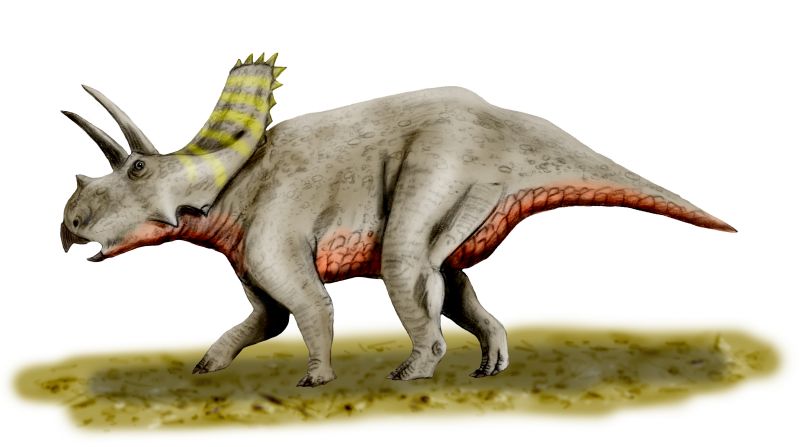- Arrhinoceratops
Taxobox
name = "Arrhinoceratops"
fossil_range =Late Cretaceous

image_width = 250px
regnum =Animal ia
phylum = Chordata
classis =Sauropsid a
superordo =Dinosaur ia
ordo =Ornithischia
subordo =Cerapoda
infraordo =Ceratopsia
familia =Ceratopsidae
subfamilia =Ceratopsinae
genus = "Arrhinoceratops"
binomial = "Arrhinoceratops brachyops"
binomial_authority = Parks, 1925"Arrhinoceratops" (meaning "no nose-horn face", derived from the
Ancient Greek "a-/α-" "no", rhino-/ρινο- "nose" "cerat-/κερατ-" "horn", "-ops/ωψ" "face") is agenus ofceratopsian dinosaur . The name was coined as its original describer concluded it had no nose-horn, however further analysis revealed this not to be the case. It lived during the earlyMaastrichtian stage of the LateCretaceous , predating its famous relative "Triceratops " by a few million years,Fact|date=July 2008 although it was contemporary with "Anchiceratops ". Its remains have been found inCanada .Discoveries and species
Described by
W. A. Parks in 1925, "Arrhinoceratops" is known from a partially crushed, slightly distorted skull which lacked a lower jaw. The remains were collected from theHorseshoe Canyon Formation Fact|date=July 2008 deposits along theRed Deer River inAlberta by a 1923 expedition from theUniversity of Toronto .Only one species is described, "A. brachyops". Other material from
Utah , named by Gilmore in 1946, was originally known as "A. utahensis", thence transferred to "Torosaurus ".Classification
"Arrhinoceratops" belonged to the Ceratopsinae (previously known as Chasmosaurinae) within the Ceratopsia (the name is Ancient Greek for "horned face"), a group of herbivorous dinosaurs with
parrot -like beaks which thrived inNorth America andAsia during the Cretaceous Period, which ended roughly 65 million years ago. It appears to be closely related to "Torosaurus "."Arrhinoceratops." In: Dodson, Peter & Britt, Brooks & Carpenter, Kenneth & Forster, Catherine A. & Gillette, David D. & Norell, Mark A. & Olshevsky, George & Parrish, J. Michael & Weishampel, David B. "The Age of Dinosaurs". Publications International, LTD. p. 127. ISBN 0-7853-0443-6.]Physical description
Since this dinosaur is known only from its skull, scientists know little about its over-all anatomy. The skull features a broad neck frill with two oval shaped openings. Its brow horns were moderately long, but its nose horn was shorter and blunter than most Ceratopsians. Its body is assumed to be typical of the Ceratopsians, and based on the skull it is estimated to be unit length|m|6 long when fully grown.
Diet
"Arrhinoceratops", like all Ceratopsians, was a
herbivore . During the Cretaceous, flowering plants were "geographically limited on the landscape", and so it is likely that this dinosaur fed on the predominant plants of the era: ferns, cycads and conifers. It would have used its sharp Ceratopsian beak to bite off the leaves or needles.Related animals
These ceratopsians were close relatives of "Arrhinoceratops".
*"
Anchiceratops "
*"Chasmosaurus "
*"Pentaceratops "
*"Torosaurus "References
* Dodson, P. (1996). "The Horned Dinosaurs". Princeton University Press, Pinceton, New Jersey, pp. xiv-346
* http://www.dinosaurvalley.com/Visiting_Drumheller/Kids_Zone/Groups_of_Dinosaurs/index.php
Wikimedia Foundation. 2010.
